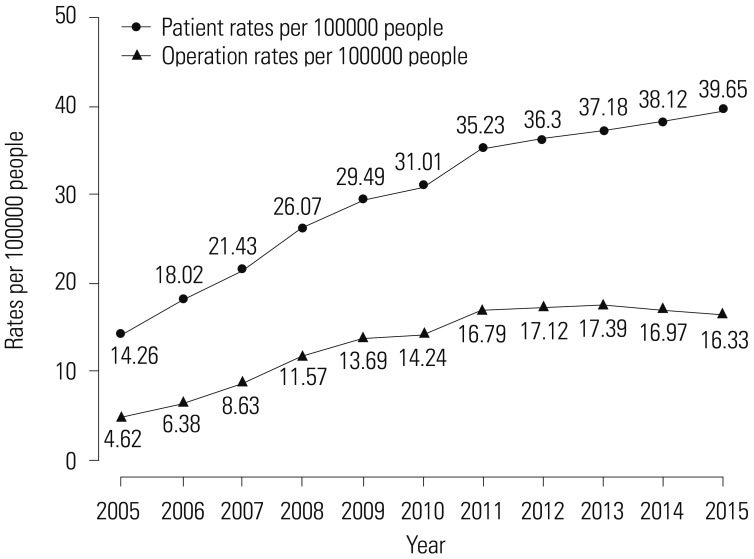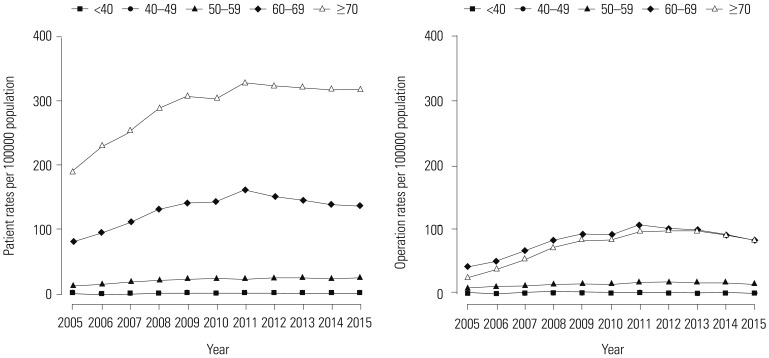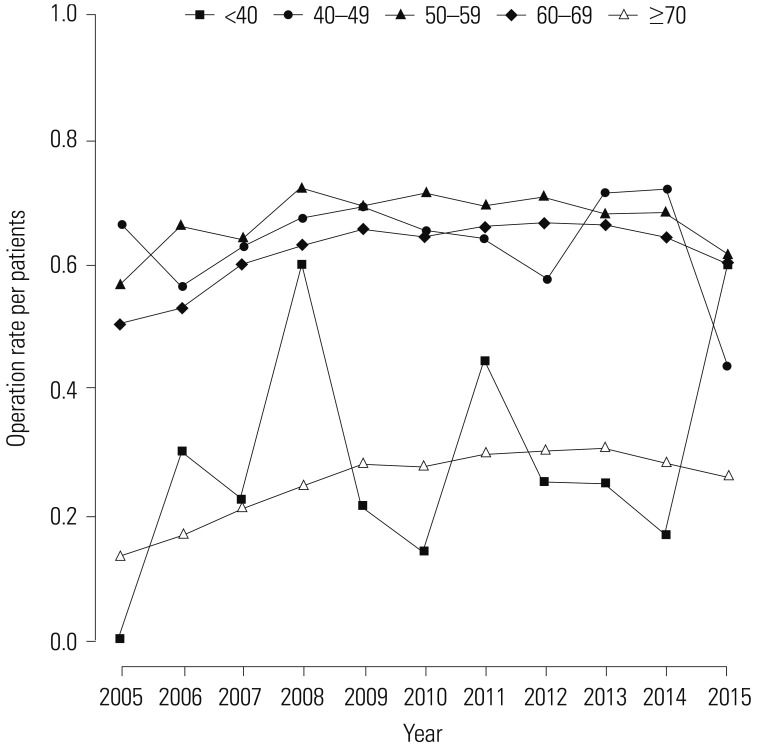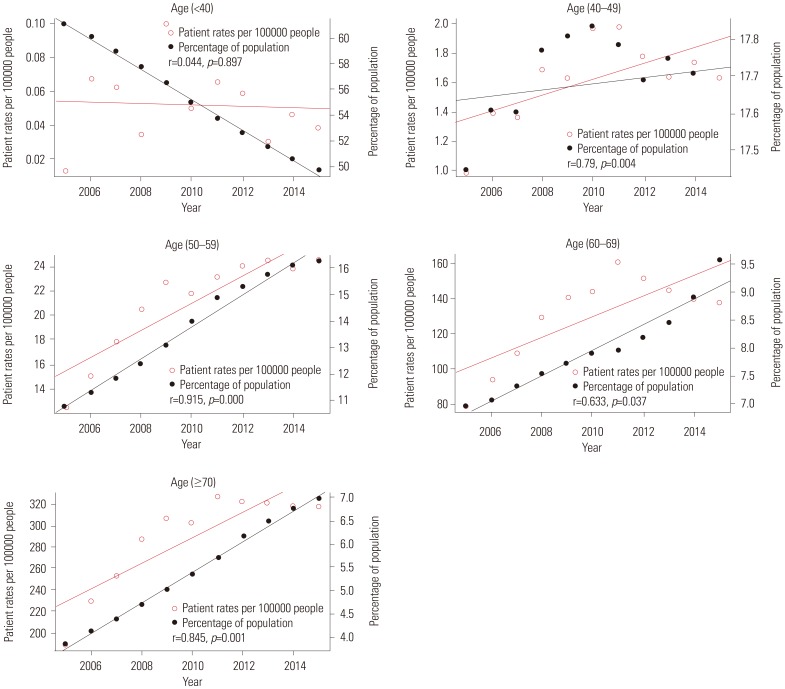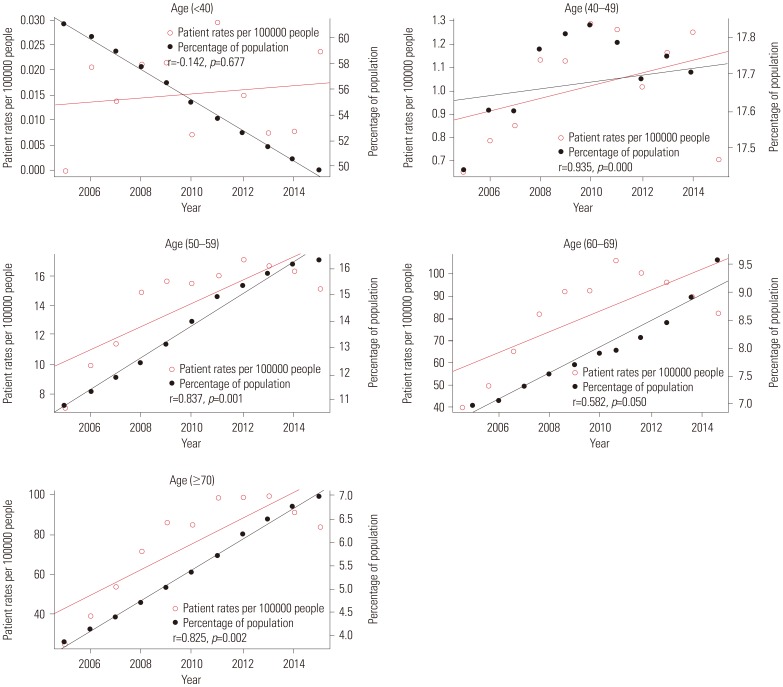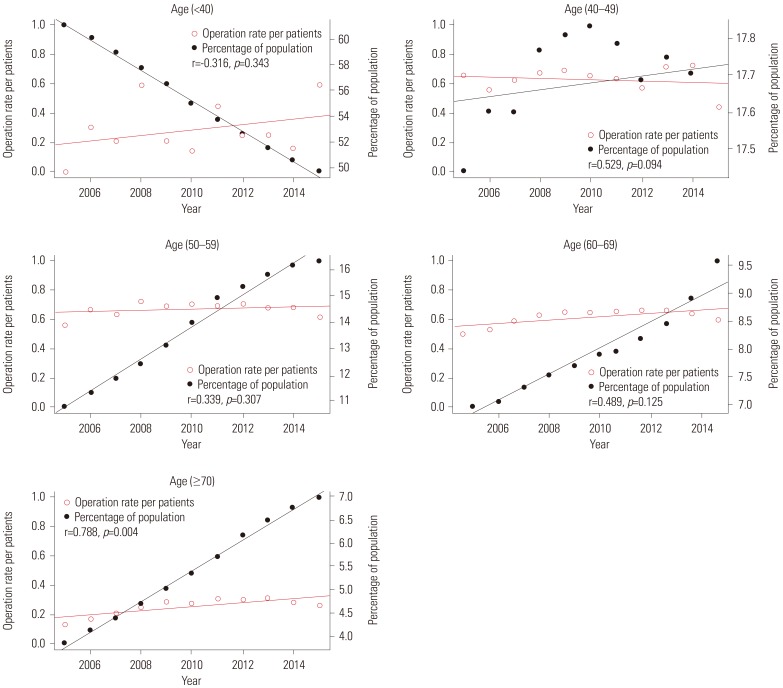Yonsei Med J.
2019 Mar;60(3):257-266. 10.3349/ymj.2019.60.3.257.
Trends in Prostate Cancer Prevalence and Radical Prostatectomy Rate according to Age Structural Changes in South Korea between 2005 and 2015
- Affiliations
-
- 1Department of Urology, Soonchunhyang University Seoul Hospital, Soonchunhyang University Medical College, Seoul, Korea. piacekjh@schmc.ac.kr
- 2Department of Biostatistics, Soonchunhyang University Seoul Hospital, Seoul, Korea.
- KMID: 2441303
- DOI: http://doi.org/10.3349/ymj.2019.60.3.257
Abstract
- PURPOSE
Radical prostatectomy (RP) is one of main treatments for prostate cancer (Pca). The prevalence of Pca has been decreasing in recent reports. However, no study has reported trends in Pca prevalence or RP rate according to age structural changes. The objective of this study was to investigate trends in Pca prevalence and frequency of RP according to age structural change.
MATERIALS AND METHODS
We evaluated trends in Pca prevalence and RP rate using National Health Insurance Data from 2005 to 2015. Relationships for Pca prevalence and RP rate with age structural change were also determined. Primary outcomes included trends in Pca prevalence and RP rates according to age groups, comparing those before and after 2011.
RESULTS
Pca prevalence tended to increase before 2011 and decreased after 2011 in persons in the 60-years age group. RP rate increased pattern before 2011 and decreased after 2011 in age groups of 50s, 60s, and over 70s. Pca prevalence and age structural change showed a significantly positive relationship in all age groups, except for the age group under 40 years. RP rate and age structural change also showed a significantly positive relationship in all age groups.
CONCLUSION
Age structural change can affect the decreasing trend in Pca prevalence and RP rate in South Korea. Future studies are needed to validate this result.
Keyword
MeSH Terms
Figure
Reference
-
1. Center MM, Jemal A, Lortet-Tieulent J, Ward E, Ferlay J, Brawley O, et al. International variation in prostate cancer incidence and mortality rates. Eur Urol. 2012; 61:1079–1092. PMID: 22424666.
Article2. Song W, Jeon HG. Incidence of kidney, bladder, and prostate cancers in Korea: an update. Korean J Urol. 2015; 56:422–428. PMID: 26078838.
Article3. Park SK, Sakoda LC, Kang D, Chokkalingam AP, Lee E, Shin HR, et al. Rising prostate cancer rates in South Korea. Prostate. 2006; 66:1285–1291. PMID: 16741923.
Article4. Lim D, Ha M, Song I. Trends in major cancer mortality in Korea, 1983-2012, with a joinpoint analysis. Cancer Epidemiol. 2015; 39:939–946. PMID: 26523983.
Article5. Sammon JD, Abdollah F, D'Amico A, Gettman M, Haese A, Suardi N, et al. Predicting life expectancy in men diagnosed with prostate cancer. Eur Urol. 2015; 68:756–765. PMID: 25819724.
Article6. Kitazawa T, Matsumoto K, Fujita S, Seto K, Hanaoka S, Hasegawa T. Cost of illness of the prostate cancer in Japan--a time-trend analysis and future projections. BMC Health Serv Res. 2015; 15:453. PMID: 26438194.
Article7. Roehrborn CG, Black LK. The economic burden of prostate cancer. BJU Int. 2011; 108:806–813. PMID: 21884356.
Article8. Mistry PK, Gaunay GS, Hoenig DM. Prediction of surgical complications in the elderly: can we improve outcomes? Asian J Urol. 2017; 4:44–49. PMID: 29264206.
Article9. Barocas DA, Alvarez J, Resnick MJ, Koyama T, Hoffman KE, Tyson MD, et al. Association between radiation therapy, surgery, or observation for localized prostate cancer and patient-reported outcomes after 3 years. JAMA. 2017; 317:1126–1140. PMID: 28324093.
Article10. Daniyal M, Siddiqui ZA, Akram M, Asif HM, Sultana S, Khan A. Epidemiology, etiology, diagnosis and treatment of prostate cancer. Asian Pac J Cancer Prev. 2014; 15:9575–9578. PMID: 25520069.
Article11. Ahlering T, Huynh LM, Kaler KS, Williams S, Osann K, Joseph J, et al. Unintended consequences of decreased PSA-based prostate cancer screening. World J Urol. 2018; 7. 12. [Epub]. Available at: . DOI: 10.1007/s00345-018-2407-3.
Article12. Chen J, Oromendia C, Halpern JA, Ballman KV. National trends in management of localized prostate cancer: a population based analysis 2004-2013. Prostate. 2018; 78:512–520. PMID: 29542178.
Article13. Ahn H, Kim HJ, Jeon SS, Kwak C, Sung GT, Kwon TG, et al. Establishment of Korean prostate cancer database by the Korean Urological Oncology Society. Investig Clin Urol. 2017; 58:434–439.
Article14. The Korean Urological Association, The Korean Urologocal Oncology Society. Korean clinical practice guideline for the treatment of prostate cancer. accessed on 2018 September 30. Available at: http://www.urology.or.kr/mail/file/180912_2.pdf.15. Lee EY, Kim HC, Rhee Y, Youm Y, Kim KM, Lee JM, et al. The Korean urban rural elderly cohort study: study design and protocol. BMC Geriatr. 2014; 14:33. PMID: 24641351.
Article16. OECD. The percentage of elderly population in South Korea. accessed on 2019 January 1. Avilable at: https://data.oecd.org/pop/elderly-population.htm.17. Baek MJ, Park S, Kim KH, Kim YH, Kim WK, Sun HY, et al. National trend of uroflowmetry, urodynamic study and cystoscopy considering the change in the population structure in Korea from 2010 to 2015. J Korean Med Sci. 2018; 33:e145. PMID: 29760605.
Article18. Park J, Suh B, Shin DW, Hong JH, Ahn H. Changing patterns of primary treatment in Korean men with prostate cancer over 10 years: a nationwide population based study. Cancer Res Treat. 2016; 48:899–906. PMID: 26511804.
Article19. Ahn HS. Overdiagnosis in health care: impact of cancer screening. J Korean Med Assoc. 2017; 60:323–329.
Article20. Townsend NT, Robinson TN. Surgical risk and comorbidity in older urologic patients. Clin Geriatr Med. 2015; 31:591–601. PMID: 26476118.
Article21. Hall MJ, DeFrances CJ, Williams SN, Golosinskiy A, Schwartzman A. National Health Statistics Reports; no 29. National hospital discharge survey: 2007 summary. Hyattsville (MD): National Center for Health Statistics;2010.22. Kweon SS. Updates on cancer epidemiology in Korea, 2018. Chonnam Med J. 2018; 54:90–100. PMID: 29854674.
Article23. Kim JH, Kim SY, Yun SJ, Chung JI, Choi H, Yu HS, et al. Medical travel among non-Seoul residents to seek prostate cancer treatment in medical facilities of Seoul. Cancer Res Treat. 2019; 51:53–64. PMID: 29458236.
Article24. Hoffman RM, Meisner AL, Arap W, Barry M, Shah SK, Zeliadt SB, et al. Trends in United States prostate cancer incidence rates by age and stage, 1995-2012. Cancer Epidemiol Biomarkers Prev. 2016; 25:259–263. PMID: 26646364.
Article25. Mathieson KM, Kronenfeld JJ, Keith VM. Maintaining functional independence in elderly adults: the roles of health status and financial resources in predicting home modifications and use of mobility equipment. Gerontologist. 2002; 42:24–31.26. Wolff RF, Ryder S, Bossi A, Briganti A, Crook J, Henry A, et al. A systematic review of randomised controlled trials of radiotherapy for localised prostate cancer. Eur J Cancer. 2015; 51:2345–2367. PMID: 26254809.
Article27. Tamada S, Ninomiya N, Kitamoto K, Kato M, Yamasaki T, Iguchi T, et al. Comparative effectiveness of radical prostatectomy and curative radiotherapy in localized prostate cancer: long-term followup. J Radiat Res. 2017; 58:552–558. PMID: 28013228.
Article28. Donovan JL, Hamdy FC, Lane JA, Mason M, Metcalfe C, Walsh E, et al. Patient-reported outcomes after monitoring, surgery, or radiotherapy for prostate cancer. N Engl J Med. 2016; 375:1425–1437. PMID: 27626365.
Article29. Resnick MJ, Koyama T, Fan KH, Albertsen PC, Goodman M, Hamilton AS, et al. Long-term functional outcomes after treatment for localized prostate cancer. N Engl J Med. 2013; 368:436–445. PMID: 23363497.
Article30. Wilt TJ, Jones KM, Barry MJ, Andriole GL, Culkin D, Wheeler T, et al. Follow-up of prostatectomy versus observation for early prostate cancer. N Engl J Med. 2017; 377:132–142. PMID: 28700844.
Article31. Hamdy FC, Donovan JL, Lane JA, Mason M, Metcalfe C, Holding C, et al. 10-year outcomes after monitoring, surgery, or radiotherapy for localized prostate cancer. N Engl J Med. 2016; 375:1415–1424. PMID: 27626136.
Article32. Hwang I, Lim D, Jeong YB, Park SC, Noh JH, Kwon DD, et al. Upgrading and upstaging of low-risk prostate cancer among Korean patients: a multicenter study. Asian J Androl. 2015; 17:811–814. PMID: 25578934.33. Park JW, Jang WS, Koh DH, Ham WS, Rha KH, Hong SJ, et al. Impact of early salvage androgen deprivation therapy in localized prostate cancer after radical prostatectomy: a propensity score matched analysis. Yonsei Med J. 2018; 59:580–587. PMID: 29869455.
Article
- Full Text Links
- Actions
-
Cited
- CITED
-
- Close
- Share
- Similar articles
-
- Radical Prostatectomy
- A Case of No Residual Cancer in Radical Prostatectomy Specimens Despite Biopsy-proven Prostate Cancer
- The Impact of PSA on Pathologic Characteristics in the Radical Prostatectomy with PSA Level of 4-10ng/ml
- Functional recovery after radical prostatectomy for prostate cancer
- Clinicopathological Significance of the Lymphovascular Invasion Detected in Specimens from Radical Retropubic Prostatectomies

